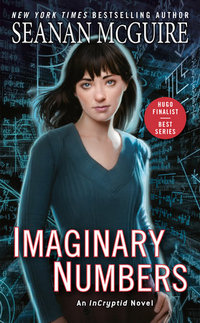 |
Imaginary Numbersby Seanan McGuire Mass Market Paperback, 365 pg. Read: June 16-19, 2020 |

What’s Imaginary Numbers About?
The Price’s cousin, Sarah, the Johrlac (aka “cuckoo”) adopted by the family years ago and last really seen in Midnight Blue-Light Special—but mentioned in almost/every book since—has finally recovered from the events of that book (5 years ago, in the series chronology), or at least recovered enough to travel on her own. She’s still not at 100% (and is further from it than anyone but Sarah realizes).
She flies out to Portland to reconnect with the family out there, and while she does reconnect with the Prices, she also finds herself connecting to a bunch of other cuckoos. Which is something that the species just doesn’t do—these telepathic apex predators have developed in such a way that they can’t share territory for long at all. So the fact that you have a group of them working together spells trouble for Sarah and any cryptozoologists trying to keep the peace between the species (and, in this case, to preserve a spot for every species that isn’t a Johrlac to live).
That’s a little brief, but I don’t know how else to be.
Imaginary Numbers’ Place in the Series
It’s been five years in series’ time, seven years and seven novels in our timeline, since we spent any real time with Sarah. I remember really liking her as a character for the first two books and couldn’t believe McGuire would do what she did to her so soon out of the gate for the series. But over the years, as she’s been largely “off screen” recovering, I’ve pretty much forgotten everything about her and what made her click for me as a character. I remembered enough to understand what a big deal it was for Sarah and Artie to see each other and to be say all they needed to say. But beyond that…it’d just been too long for me. Maybe if I’d re-read Midnight Blue-Light Special recently (or ever), this wouldn’t have been a problem.
This is our fourth narrator (fourth plus? There’s a lot of this book not narrated by Sarah) in this series, and like most fans, I’ve embraced that as a feature and as a strength. But this one feels more like a sequel to the Annie books (the previous three novels) than we usually get with a narrator switch. There’s a direct connection between the events of Verity’s Chaos Choreography and Annie’s Magic for Nothing, and all the other books show an awareness of the others. But the cast from <‘b>That Ain’t Witchcraft is present and accounted for here, and Imaginary Numbers is happening in its shadow. This isn’t good bad or indifferent, it just gives this book a different vibe than I’m used to in this series.
And the way this ends is pretty different, too—McGuire hasn’t given us a cliffhanger (this is a pretty complete story, thankfully) before. It’s a good one, but, again, not something I’m used to in these books.
One of the advantages of the way this series is set up is that it can do things like this—each book, or each “set” of books*, can take on a different flavor, a different way of approaching the story, a different way to fit in the series, a different way to end a book. While all being part of a larger, overarching story. But there are some dangers with this approach, too. And right now I’m not sure what to think of the Sarah set’s approach.
* The initial “Verity” set, the “Alex” set, then the three “Annie”s and now, two (at least) “Sarah”s, I’m not sure how to group the Verity novel between the Alex and Annie sets.
Hail, Aeslin Mice!
There was much rejoicing here (and I’m betting among all fans) that the Aeslin Mice were back in these pages. If we took nothing else from their absence in the last two books, it’s just how important they are for the telling of these stories—they’re far more than comic relief (although they are that), and for me, the best emotional moments of this particular novel came from them.
So, what did I think about Imaginary Numbers?
I liked it, but not as much as I expected to, not as much as I wanted to. There was just so much space devoted to getting everyone caught up with Sarah (and reminding us who she was/what happened to her). Then another big chunk explaining Jorlacs—and then there was another exposition dump when the Johrlacs explained what was going on to Sarah (and then another chunk when it was explained to the Prices). Just so much talking that it felt like the story got pushed out of the way.
Based on the way this ended, I’m not sure I can actually say what I thought about the book. I might have to wait until the end of Calculated Risks. Still, I enjoyed it. I like this world, I like the characters. McGurie writes a good book, and is probably incapable of writing anything but.

This post contains an affiliate link. If you purchase from it, I will get a small commission at no additional cost to you. As always, opinions are my own.
![]()



1 Pingback